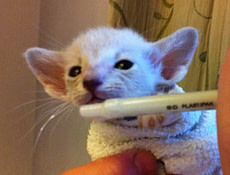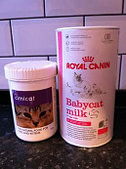 Hand feeding kittens is something every cat breeder will have to do at one time or another. Follow this comprehensive guide and learn how to hand feed kittens.
Hand feeding kittens is something every cat breeder will have to do at one time or another. Follow this comprehensive guide and learn how to hand feed kittens.
When I first started breeding, I had an idea that I would occasionally have to hand feed kittens and I had cosy images of orphaned kittens in front of the Aga and milk bottles being warmed up. However the realities of being responsible for tiny lives soon hit home when I was suddenly left with seven newborn kittens to hand feed and my rose tinted glasses were firmly dislodged at my first 2am feed.
I wrote this article to share my experiences of hand feeding kittens as when I started breeding it was a steep learning curve. I trawled through the internet reading everything I could and then learned quickly through a great deal of trial and error. Everyone has their own favourite methods and tips however this is the method that works best for me.
Why Hand Feed Kittens?
There are a variety of problems with the queen or kittens that prevents the kittens from feeding. The list below covers some of the common situations for breeders.
- The kittens are orphaned.
- There are too many kittens for the queen to feed by herself e.g eight kittens and the smaller kittens are clearly struggling.
- The queen is unwell or has had certain types of medication that means she should not feed them (your vet can advise you on this).
- The queen has had a c-section and may be still sleepy or reluctant to feed her kittens at first so until the queen can take over, the kittens will need hand feeding.
- The queen has a different blood group than the kittens so the kittens need to be hand fed for the first day to avoid them having colostrum (not in Siamese or Oriental breeds)
- The kittens may be too weak or unwell and this may stop them feeding. If this is the case, then the kitten may just need a little help through topping up feeds for a few days to gain strength and health to feed from mum again.
When Should You Start Hand Feeding Kittens?
As a breeder, you will need to keep a careful eye on your kittens’ health and well being. The first sign that something is wrong is usually when a kitten fails to gain weight or begins to lose weight. The best way to keep a close eye on this is through weighing your kittens once or twice a day. As general rule or thumb and depending on the breed, you can expect around a ten gram weight gain each day, however all kittens are different. This does not mean you should panic if your kitten only gains nine grams or even if they only gain four or five grams. Ideally you should look at the overall pattern; is the kitten gaining some weight most days? Is she content between feeds? Does she look like she is gaining weight? Is she well hydrated and is she toileting? If the answer to any of these questions is no, then you should consider hand feeding although it may be best to ask your vet or another experienced breeder’s advice first. Remember, hand feeding is a lifeline to those kittens that need it but it is not something to be undertaken lightly.
Hand Feeding Kittens – The Basics
Ideally a kitten should stay with their mother when they are being hand fed unless the situation means they really must be separated, for instance if the mother is too unwell or on medication that could pass to the kittens through her milk. In that case you must keep the kittens in a warm box with a heat pad as the kittens will be unable to regulate their own temperature for the first few weeks. A queen really does know best when rearing kittens and you will need to take the place of mother as best you can, giving the kittens care and love, cleaning them and toileting them as well as hand feeding. This is a full time job that takes a lot of care and patience!
 Which Milk?
Which Milk?
Kittens need a specific balance of fat, carbohydrate and vitamins that can’t be found in cow’s milk so it is important you use a specific kitten milk. This will give them all the energy and nutrients they need to grow and prevent it upsetting their stomachs. There are several commercial milk powders available on the internet or from your vets, or alternatively you can make your own kitten gloop.
What To Use?
There are several choices of equipment and different breeders will have their favourites that work for them. Below is a brief overview of their advantages and disadvantages;
- Syringes are an excellent way to feed a kitten who may be reluctant, too weak or sick to suckle, however care must be taken not to flood a kitten’s lungs.
- Bottle feeding allows the kitten to suckle more naturally however a reluctant feeder or one that is too weak may struggle to suckle from a bottle.
- Tube feeding kittens ensures the kitten receives all the milk they need straight to their stomach, however it is dangerous if the tube is wrongly inserted.
All have their advantages however I am going to focus on syringe feeding I have found this more successful that bottle feeding in newborns. I would warn against using teats on the end of syringes as these can easily be swallowed by kittens with disastrous consequences.
 Sterilising
Sterilising
When kittens are being hand fed, they will not be receiving antibodies from their mother that helps build up their resistance to bugs and infection. This leaves the kittens very vulnerable to infection, particularly that caused by poorly washed equipment. Syringes are hard to get completely clean and for that reason, I like to sterilise all my equipment before use. It is simple to sterilise equipment using a cheap microwave steam steriliser available from any baby shop.
What Equipment Will I Need?
If you are expecting a litter of kittens, it may be useful to have a few kitten hand feeding essentials to hand.
Essentials
- Syringes, particularly 1mm small syringes either sterilised or in sterile packaging (available from vets or medical suppliers).
- Clean container to mix milk
- Milk powder or ingredients for kitten gloop
There are other items that aren’t essential but will make your life easier if you are hand feeding kittens regularly or for a long time.
- Bottles to store milk – I use baby bottles that can be sealed and sterilised.
- Steriliser.
- Material to wrap the kitten and clean up spills – I use muslin or terry towelling available from baby shops however small towels, flannels or tea towels would be just as good.
- Scales – to keep an eye on how much weight the kitten is gaining.
- Pots for milk – I use baby food pots, again from a baby shop.
- Dish to warm the pots of milk – I have found the little glass dishes you get with ‘posh’ puddings to be the perfect size.
 Preparing Milk For Hand Feeding Kittens
Preparing Milk For Hand Feeding Kittens
Commercial milk powders are very easy to prepare and it is best to follow the instructions carefully. Take care to use boiled water that has cooled to blood temperature as this will mix best with the powder. If you make up enough for a day (follow the guidelines on the side to work out how much each kitten needs) you can store the milk in the fridge for up to twenty-four hours.[divider_flat]
 How To Hand Feed Kittens
How To Hand Feed Kittens
- You will need to warm the milk up before you feed the kitten as cold milk can stagnate in the stomach and be dangerous for young kittens. I pour the amount of milk I need into a baby food pot and warm it in a dish filled with boiling water. Make sure you check the temperature of your milk before hand feeding the kitten to make sure it is not too hot or cold; a good way to tell is to squirt a little onto your inner wrist or elbow.
- Wrap your kitten up in your towel leaving just her head free and completely enclosing her legs to stop her struggling away from the syringe.
- Position your kitten sitting upright in one hand and offer her the syringe of milk with the other hand. 1ml syringes are the best size to use for new born kittens as they allow you better control of the flow of milk.
- Hold the syringe with your hand around the barrel and your thumb on the depressor. This will give you more control than if you hold the barrel between your fingers.


- Insert the syringe gently to the side of the kitten’s mouth. Never hold the syringe at the front of the mouth angled down the kitten’s throat as this could flood her lungs.
Depress the syringe very slowly allowing the kitten plenty of chance to swallow the milk. Often kittens can struggle refuse to swallow, using their tongue to push the milk out their mouth. This requires plenty of patience and perseverance to encourage the kitten that the milk isn’t poison! A good sign that your kitten is taking the milk is if she is gaining weight and has a fat belly.
How Often Should I Hand Feed the Kittens?
Kitten milk packaging will give you a guide of how much to feed your kittens but generally a newborn kitten will need 2ml of milk every two hours day and night. This means you will need to set your alarm through the night and you may also need to take time off from work to feed your kittens through the day so you will need an understanding boss! It can be exhausting work, especially if you are feeding a whole litter of kittens. When feeding a litter of seven or eight, often by the time you have fed the last kitten, it is time to start over again!
As the kittens grow older, the gaps between feeds will be longer and you may actually get some sleep at night. Then finally by four weeks, the end is in sight as the kittens begin to wean and you can look forward to a well deserved rest.
Aspiration Pneumonia Dangers When Hand Feeding Kittens
When you are feeding kittens, you must be very careful that the milk doesn’t go down the kitten’s nose or lungs as this can cause aspiration pneumonia; this is potentially fatal for kittens. A sign that the kitten may have inhaled milk will be a milky bubble or milk coming out the kitten’s nose. In that case, fast action is essential; turn the kitten upside down and rub and pat her chest to clear her lungs or use a baby nasal aspirator to suck out the milk. If you are confident doing so, turn the kitten upside down, support her head between your index and middle finger, and swing her upside down, wiping her nose after each swing to clear the milk.
If you suspect your kitten has aspirated milk, she should be taken immediately to your vet as she will most likely need a course of antibiotics. This will prevent the milk becoming infected causing aspiration pneumonia.
Toileting Kittens

The best time to toilet a kitten is before and after her feed. She may also need to be toileted if she appears uncomfortable or reluctant to feed.
Hopefully you will have a litter of kittens and they will have lovely fat bellies, suckle from mum contentedly and gain weight steadily. However, in breeding, there will be times you need to make the decision to hand feed a kitten or a litter. By preparing yourself beforehand, you will be informed to make the decision to intervene through hand feeding and be confident that you can do this successfully.









This is a totally totally awesome article… well done Joanne xx
Fantastic article Jo – very informative and one I plan to keep referring to!